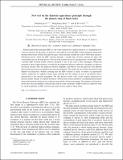Files in this item
New test on the Einstein equivalence principle through the photon ring of black holes
Item metadata
| dc.contributor.author | Li, Chunlong | |
| dc.contributor.author | Zhao, Hongsheng | |
| dc.contributor.author | Cai, Yi Fu | |
| dc.date.accessioned | 2021-09-22T11:30:02Z | |
| dc.date.available | 2021-09-22T11:30:02Z | |
| dc.date.issued | 2021-09-15 | |
| dc.identifier | 274560069 | |
| dc.identifier | 5bfd0c40-f100-4c24-bc2e-3224db501e07 | |
| dc.identifier | 000694044200007 | |
| dc.identifier | 85114880726 | |
| dc.identifier.citation | Li , C , Zhao , H & Cai , Y F 2021 , ' New test on the Einstein equivalence principle through the photon ring of black holes ' , Physical Review D - Particles, Fields, Gravitation and Cosmology , vol. 104 , no. 6 , 064027 . https://doi.org/10.1103/PhysRevD.104.064027 | en |
| dc.identifier.issn | 1550-7998 | |
| dc.identifier.other | ArXiv: http://arxiv.org/abs/2102.10888v2 | |
| dc.identifier.uri | https://hdl.handle.net/10023/23996 | |
| dc.description | Funding: This work is supported in part by the NSFC (Nos. 11653002, 11961131007, 11722327,1201101448, 11421303), by the CAST (2016QNRC001), by the National Thousand Talents Program of China, by the Fundamental Research Funds for Central Universities, and by the USTC Fellowship for international cooperation. | en |
| dc.description.abstract | Einstein equivalence principle (EEP), as one of the foundations of general relativity, is a fundamental test of gravity theories. In this paper, we propose a new method to test the EEP of electromagnetic interactions through observations of black hole photon rings, which naturally extends the scale of Newtonian and post-Newtonian gravity where the EEP violation through a variable fine structure constant has been well constrained to that of stronger gravity. We start from a general form of Lagrangian that violates EEP, where a specific EEP violation model could be regarded as one of the cases of this Lagrangian. Within the geometrical optical approximation, we find that the dispersion relation of photons is modified: for photons moving in circular orbit, the dispersion relation simplifies, and behaves such that photons with different linear polarizations perceive different gravitational potentials. This makes the size of black hole photon ring depend on polarization. Further assuming that the EEP violation is small, we derive an approximate analytic expression for spherical black holes showing that the change in size of the photon ring is proportional to the violation parameters. We also discuss several cases of this analytic expression for specific models. Finally, we explore the effects of black hole rotation and derive a modified proportionality relation between the change in size of photon ring and the violation parameters. The numerical and analytic results show that the influence of black hole rotation on the constraints of EEP violation is relatively weak for small magnitude of EEP violation and small rotation speed of black holes. | |
| dc.format.extent | 16 | |
| dc.format.extent | 760393 | |
| dc.language.iso | eng | |
| dc.relation.ispartof | Physical Review D - Particles, Fields, Gravitation and Cosmology | en |
| dc.subject | Quantum-electrodynamic corrections | en |
| dc.subject | Constant | en |
| dc.subject | Gravity | en |
| dc.subject | QB Astronomy | en |
| dc.subject | QC Physics | en |
| dc.subject | Physics and Astronomy (miscellaneous) | en |
| dc.subject | T-NDAS | en |
| dc.subject | MCC | en |
| dc.subject | NCAD | en |
| dc.subject.lcc | QB | en |
| dc.subject.lcc | QC | en |
| dc.title | New test on the Einstein equivalence principle through the photon ring of black holes | en |
| dc.type | Journal article | en |
| dc.contributor.institution | University of St Andrews. School of Physics and Astronomy | en |
| dc.identifier.doi | 10.1103/PhysRevD.104.064027 | |
| dc.description.status | Peer reviewed | en |
This item appears in the following Collection(s)
Items in the St Andrews Research Repository are protected by copyright, with all rights reserved, unless otherwise indicated.

